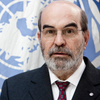The 2015 deadline for meeting the Millennium Development Goals is fast approaching. It is time to take stock of progress and see what still needs to be done. Advance towards MDG 1, halving prevalence of hunger has been varied, but with one final push we still can reach the MDG hunger target.
Thirty eight countries have already been successful in halving the proportion of chronically undernourished people. Eighteen of them have also reached the more ambitious goal of halving the absolute number of hungry people set by the World Food Summit organized by FAO in 1996.
These countries prove that ending hunger is possible. They should inspire us to set an even bolder goal than hunger reduction -- the complete eradication of hunger and malnutrition.
Despite the progress we have made the fact remains that today 870 million people are hungry worldwide, and this figure represents only a fraction of the world's population whose health and lives are blighted by malnutrition.
It is estimated that 26 percent of the world's children are stunted, two billion people suffer from a lack of the essential vitamins and minerals needed for mental and physical development, and nearly 500 million people are obese.
The true toll of malnutrition, in terms of human suffering and poor health, is enormous. It is estimated that the cost of malnutrition to the global economy in lost productivity and direct health care could account for as much as 5 percent of the global gross domestic product -- $3.5 trillion dollars, the equivalent to $500 per person, and close to the GDP of Germany.
But what can we do to eradicate malnutrition? This year's edition of FAO's publication, The State of Food and Agriculture: Food systems for better nutrition, gives us some answers to this question.
Healthy diets and good nutrition must start with food and agriculture. The way we grow, raise, process, transport and distribute food influences what we eat.
Improved food systems can make food more affordable, diverse and nutritious.
We need agricultural policies and investment in research to increase productivity not only of staple grains like maize, rice and wheat, but also of legumes, meat, milk, vegetables and fruit, which are all rich in nutrients.
Cutting food losses and waste can also help make food more available and affordable as well as reduce pressure on land and other resources.
Properly organized food systems are key to more diversified and healthy diets. Finally, we need to help consumers make good dietary choices for better nutrition through education, information and other interventions.
Importantly, food systems must be made more responsive to the needs of mothers and young children. Malnutrition during the critical first 1000 days can cause life-long physical and cognitive impairment in children.
Giving women greater control over resources and incomes will benefit their and their children's health. Policies, interventions and investment in labour-saving farming technologies and rural infrastructure, targeted social safety nets and services can make important contributions to the health and nutrition of women, infants and young children.
Making food systems better able to enhance nutrition is a complex task requiring strong political commitment and leadership at the highest levels along with broad-based partnerships. The policy decisions we make must ensure that all people have access to a wide range of nutritious foods and to the knowledge and information they need to make healthy choices.
Food security and nutrition are now at the very top of the international sustainable development agenda. We must be bold and take the step of committing to the total eradication of hunger and malnutrition. Within our lifetimes, as originally proposed by UN Secretary-General Ban Ki-moon in his Zero Hunger Challenge, or, even more ambitiously, by 2025.
